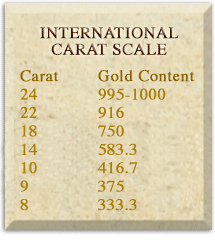A
Alloy
Alluvial Gold
Approved refiner
Assay
- For a “refined” gold assay, a small sample of the gold to be tested is weighed. In the case of ore assaying, a quantity of raw material is crushed and a sample taken.
- This is placed in a small crucible or cupel, with lead oxide, a carbon reducing agent and fluxes of silica sand, borax and fluorite, and melted in a muffle furnace.
- The molten contents are poured into a cone and cooled, leaving the lead, gold and any silver in a single “button” at the bottom.
- This lead button is then placed into a cuple, which is a dish made of bone ash, and placed into a cupelling furnace to be re-melted. During this process the lead is oxidized and absorbed and into the cupel, leaving any gold and silver as a small button.
- The silver is then dissolved out of the bead with nitric acid, and the remainder is pure gold. This is then reweighed and compared with the weight of the original test sample. In the case of an ore assay, a report can be given as to the gold and silver content per given ore sample tested.
Assayer
Atomic Weight
Au
Avoirdupois Ounce
B
Bank for International Settlements
Baht
Bar
Gold is marketed in a wide range of bars, some of which are particular to individual countries. Their weight is always quoted in troy ounces or in grams (kilograms). For international acceptance or delivery however, they must conform to specific standards set by the London Bullion Market Association or futures exchanges and bear the marks of recognized smelters and assayers. The main bars traded internationally are the 400 troy ounces (12.5 kilo) good delivery bar or the 1-kilo bar (32.15 troy ounces), such bars normally being 995 fine or 999.9 fine. American futures exchanges normally accept 100 troy ounce (3.11 kilos) for delivery. Many countries offer various small bars, ingots and wafers in weights ranging from 1 gram to 500 grams.
Other popular bars traded include:
- Baht (Thailand) = 0.47 troy ounces or 15.4 grams
- Tael (Hong Kong) = 1.2 troy ounce or 37.3 grams
- Ten tolas (Indian sub-continent/Arabian gulf) = 3.75 troy ounces or 116.6 grams
Black Gold
Bretton Woods Agreement (1944)
Bullion
Today, bullion is a term used to describe gold and silver in its pure form that being 22 carat gold or greater. For example the American Eagle gold coin and the British sovereign gold coin are considered bullion coins and are 22 carat gold. Some Jurisdictions however determine bullion by a more technical definition, whereby they look at the process in which it came into being. For egsample, poured gold of a purity of 995 or greater is determined as being bullion under Australian ordinance, but 995 in fabricated form is not classified as bullion.
Bullion Coin
The first one-ounce legal tender gold coin, without a declared face value, was released in 1970 in South Africa. The Krugerrand sold at a premium of 3% over its gold content. Its success was so great that it was followed by the Canadian Maple Leaf, China’s Panda, Australia’s Nugget, Britain’s Britannia, the United States’ Eagle, Belgium’s ECU and Austria’s Philharmoniker. The demand for these coins was such that they were soon followed by a ½ ounce, ¼ ounce and 1/10-ounce version. The challenge to investors was that these coins, being legal tender were “owned” by the issuing government, and the investor was merely the bearer or the coin, not the owner. This encumbrance does not exist with private issue gold or silver coin. Today a gold coin of 22 carat or better is referred to as a Bullion Coin. These could be either government or private issue. The British Sovereign and the American Eagle are two 22-carat modern examples referred to as bullion coins.
C
Carat
Casting
Certificates
Coins
Thereafter, gold, silver and copper coins came into increasing usage as a means of exchange. Silver proved to be the most popular, simply because of its greater natural occurrence in the earths crust than gold, yet still being a “rare” metal. There is fifteen times more silver in the earths crust than gold. Many government worldwide, over the centuries have used gold and silver coinage, only to all fall to the same temptation of debasing the coin by replacing the precious metals with common metals, thereby permitting mass issuance of legal tender without any intrinsic value as backing.
D
Debase
Delivery
Dental Gold
Dinar
Dirham or Dirhem
Dry Blowing
E
Electrum
F
Fabricated Gold or Fabrication
Fine Ounce
Fine Weight
Foil
Fool's Gold
Force Majeure
Fort Knox
Four Nines (999.9)
G
Gilding
Gold
- Atomic Number: 79
- Atomic Weight: 196.967
- Melting Point: 1063degrees C
- Specific gravity: 19.32 –the sixth heaviest metal
- Hardness: (Moh’s Scale) 2.5-3.0
- Tensile Strength: 11.9
- Found in the Earth’s crust at 0.005ppm. It is estimated that nearly 130,000 tonnes have been mined.
Gold Beater
Gold and Silver Standard
Gold Leaf
Gold Leasing
Gold Overlay
Gold Plating
Good Delivery Bar
Grain
- 1 grain = 0.0648 grams or 0.002083 troy ounces.
- 15.43 grains = 1 gram
- 480.6 grains = 1 troy ounce
- 24 grains = 1 pennyweight
Gross Weight
H
Hallmark
In 1327, King Edward III of England granted a charter to the “Worshipful Company of Goldsmiths”. This body, based at London’s “Hall of the Worshipful Company of Goldsmiths” is where the term “hall-mark” originated.
Hard Money
Hong Kong Gold and Silver Exchange Society
I
Istanbul Gold Exchange
K
Kilo Bar
Kim-Thanh
L
Legal Tender
Loco
London Bullion Market Association (LBMA)
M
M1 Money Supply
Mexico
Mint
- Australia; Perth Mint, operated by the Western Australia government’s Gold Corporation makes the Nugget Bullion coin and special issues, such as Sydney 2000 Olympic Coins. The Royal Australian Mint mainly issues collector coins.
- Austria; Austrian Mint; making Philharmoniker coin and formerly, the 100 Corona re-strike.
- Canada: Royal Canadian Mint; making Maple Leaf bullion coin and special issues;
- Chine; China Mint, Beijing, making Panda Coin
- Mexico; Casa de Moneda, making Centenario coin and special issue
- Singapore; Singapore Mint, part of Chartered Industries, making some special gold coin issues;
- South Africa; The South African Mint, making Krugerrand and some special issues of one and two rand coins;
- United Kingdom; Royal Mint, making Britannia bullion coin, Sovereigns and some special issue proof coins for other clients;
- United States of America; United States Mint, making the Eagle bullion coin.
N
Nugget
P
Paper Money
Pennyweight
Penoles
Proof Coins
Pure Gold
R
Rolled Gold/Rolled Gold Plate
S
Shekel
Silver
- Atomic Number: 47
- Atomic Weight: 107.8682
- Melting Point: 961.78degrees C
- Specific gravity: 10.5
- Hardness: (Moh’s Scale) 2.5
- It is found in the Earth’s crust at 0.075ppm
Silver:Gold Ratio
Solid Gold
Souk
Spot Price
Stirling Silver
T
Taxation
Tax Haven
Tael
Tola
Torreon
Touchstone
Troy Ounce
- 32.15 troy ounces = 1 kilogram
- 1000 troy ounce bar = 31 kilograms
- 400 troy ounce gold bar = 12.5 kilograms (1000grams)
- 1 troy ounce = 480 grains
- 1 troy ounce = 20 penny weights (North America)
- 6.02 troy ounces = 5 taels (Hong Kong)
- 3.75 troy ounces = 10 tolas (Indian)
- 1 troy ounce = 155.52 metric carats (diamonds and gemstones).

